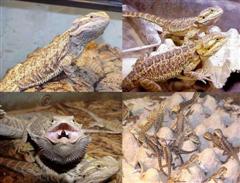Agama - Tree Dragon
Crested River Dragon, Crested Lizard, Great Angleheaded Lizard Scientific Name: Gonocephalus grandis
Sat, 16th November, 2024 - 4:16 pm GMT
Sponsor Ads:

Alternative Name
Crested River Dragon, Crested Lizard, Great Angleheaded Lizard Scientific Name: Gonocephalus grandisBasic Info
Although most Crested Tree Dragons are between 10 and 24 inches in length, it is reported that some have grown to more than three feet long. Their tails are long, and their feet are clawed to assist with climbing. A crest runs down the length of the Crested Tree Dragon's body, and some have spikes over the large dewlaps that are present in males. Crested Tree Dragons have laterally flat bodies, and bony ridges underneath the facial skin between the eyes, that are strongly evident. Because of their strongly angular head shapes, they are also known as Anglehead Dragons. They are blue in color; although colors vary in shades, they are usually bright blue. Darker green markings, particularly stripes, are seen over the body of the Crested Tree Dragon.
Health
Crested Tree Dragons are usually wild caught, so it is especially important to have a veterinarian examine newly acquired animals, as they may be have internal parasites. Their terrariums should have branches for climbing and plenty of hiding places. The Crested Tree Dragon should have access to water at all times. Some may enjoy bathing. Daytime temperatures should be about 80 degrees Fahrenheit, with a basking area about 90 degrees. The nighttime temperature should fall be about 75 degrees Fahrenheit. Full spectrum lighting is important. The diet of captive Crested Tree Dragons usually consists of various insects and pinkie mice. Breeding Crested Tree Dragons may be sexed by the presence of a dewlap, which indicates a male. They often breed year round. In the wild, they lay two to six eggs among tree roots or another sheltered, though not covered, area. Usually, incubation lasts about four months before hatchlings between 3 and 6 inches emerge.Habitat
Found in Indonesia and even as far south as Australia and New Guinea.Behavior
The Crested Tree Dragon, with its surprising appearance and interesting habits, makes a neat pet! These animals are equally amazing to observe in the wild, blending into their environment with their incredible camouflage. Mainly arboreal as their name indicates, Crested Tree Dragons are often found in the upper canopies of their forested habitats. They do come down to the ground occasionally, and bask from time to time. Crested Tree Dragons have also been noted in water, though they do not spend the majority of their time there. They can change color slightly in response to environmental conditions, and they can lose their tails. It is not believed that they are able to regenerate lost tails. Crested Tree Dragons have good eyesight and eat invertebrates in the wild. They may also eat other small animals.Origin
IndonesiaHistory
Native to southeastern Asia, Crested Tree Dragons have been found in Indonesia and even as far south as Australia and New Guinea. They tend to live in humid tropical forests or humid mountain forests that are densely packed with vegetation. They are a new addition to the pet trade, so not much information is yet available about these lizards; however, so far, they seem to be quite popular among herpetologists.Common Foods
N/ASponsor Ads:
Those who cannot remember the past are condemned to repeat it. -- George Santayana
Agama - Tree Dragon
Coded by: BGID® | ALL RIGHTS RESERVED Copyright © 2000-2024
Disclaimer | Privacy | Report Errors / Contact | Credits


 Beware the new Naval power, they are planning to come on stream with big naval might to match their ground forces. Chinese Aircraft Carrier - Chinese Navy
Beware the new Naval power, they are planning to come on stream with big naval might to match their ground forces. Chinese Aircraft Carrier - Chinese Navy  versus
versus 
 versus
versus  This Thread is about the North Korean Military itself - the kind of army, navy, and air force they have.
This Thread is about the North Korean Military itself - the kind of army, navy, and air force they have. 
 versus
versus  versus
versus 
 versus
versus  versus
versus